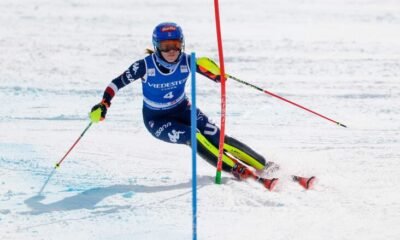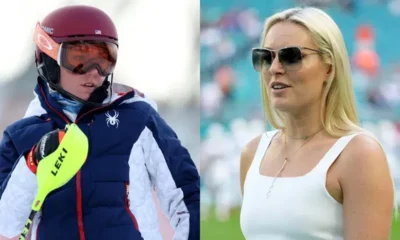Blog
Brignone, the overall ski champion, was released from the hospital following a leg break.
Overall World Cup skiing champion Federica Brignone’s recent hospitalization and subsequent release after a severe leg injury have sent shockwaves through the alpine skiing community and raised concerns about the future of one of Italy’s most decorated athletes. In a dramatic turn of events during the Italian championships at the Lusia ski area in Val di Fassa on April 3, 2025, Brignone suffered multiple fractures in her left leg—including a break in critical bone structures and a torn anterior cruciate ligament (ACL). Despite the gravity of the incident, the news that she has been discharged from the hospital marks the beginning of a long and challenging road to recovery, filled with both professional uncertainty and personal determination. This article offers an in‐depth exploration of the incident, her extraordinary career, the implications of her injury for upcoming competitions including the Milan-Cortina Olympics, and what this means for the future of alpine skiing in Italy and beyond.
A Sudden Turn on the Slopes
Federica Brignone’s accident occurred during what was supposed to be a celebratory closing chapter of her most successful season yet. With the World Cup circuit witnessing one of her best displays—amassing ten World Cup wins across three disciplines (giant slalom, super-G, and downhill)—the fall on April 3 proved to be both shocking and heartbreaking. In her second run of the giant slalom at the Italian championships, Brignone lost control after a challenging phase through the gates. This resulted in a cascade of events in which she tumbled through not only one but at least two gates, leading to a collision with the course that shattered the competitive mood of the event. As emergency services arrived, the severity of the injuries became apparent. Brignone was immediately flown by helicopter to a hospital in Trento, later transferred to Milan for urgent surgical intervention.
Medical Details and the Immediate Aftermath
Brignone’s injuries were confirmed to be extensive. Radiological examinations, including computed tomography (CT) scans, revealed multiple fractures, most notably in the tibial plateau and fibula, as well as significant trauma to the surrounding soft tissues. Added to this, she sustained a tear in her ACL—a ligament critical for stabilizing the knee during the rigorous demands of alpine skiing. Her treating physicians lauded the swift medical intervention that helped reduce complications by minimizing waiting time between the accident and surgery. “Everything they did to reduce the waiting time and avoid complications was decisive,” Brignone remarked shortly after her surgery, underscoring her gratitude toward the medical team and the rapid response coordinated by the Italian Winter Sports Federation.
During her brief stay, Brignone was able to express a mixture of realism and determination regarding her recovery. Seated in a wheelchair outside the La Madonnina clinic in Milan while speaking to reporters, she admitted, “I still don’t know how long it will take to return. We’ll go step by step. The next step is post-operation therapy and we’ll start Monday. And then we’ll see how the bone reacts and we’ll take it from there.” This candid approach to her recovery reflects a deep understanding of the uncertainty that now shrouds her competitive future.
A Champion’s Career: The Making of an Alpine Legend
Federica Brignone has long been a figure of inspiration in the world of alpine skiing. Making her World Cup debut at just 17 and riding a meteoric rise through the ranks, she has amassed an impressive record over nearly two decades. Her breakthrough came early, winning her first medal at the 2011 World Championships in Garmisch-Partenkirchen, where she secured a silver in giant slalom. Brignone’s perseverance and skill culminated in her winning the overall crystal globe in the 2020 World Cup season, making her the first Italian woman to achieve this prestigious honor. Her subsequent successes—winning the giant slalom at the world championships, taking silver in super-G events, and most recently dominating across three disciplines in the 2025 season—have cemented her status as one of the sport’s true greats.
Her record-breaking season of 2025 saw Brignone secure victories in ten World Cup races, including her first downhill wins, a development that had sparked considerable excitement about her evolving versatility on the slopes. At 34, she continues to defy the conventional peak-age expectations in alpine skiing, serving as an embodiment of resilience and ongoing excellence. Every win and podium finish in her illustrious career is a reminder of her relentless drive, and now, this injury prompts an even deeper appreciation for the physical toll the sport demands.
The Injury’s Implications for the Milan-Cortina Olympics
One of the most immediate concerns following the incident is the impact on Brignone’s ability to compete in the highly anticipated Milan-Cortina Olympic Games scheduled to take place just 10 months from the accident. As one of Italy’s marquee athletes and a fan favorite, her potential participation is a subject of intense scrutiny. The torn ACL coupled with the multiple fractures poses significant challenges, not only in terms of initial recovery but also concerning the rigorous rehabilitation required to return to top form. Italian Winter Sports Federation medical chief Andrea Panzeri cautioned that it would be “at least 45 days” before they could even begin to develop a realistic timeline for her return to racing. Given the complexities involved in healing bone injuries combined with ligament repair, experts have suggested that a full return to competitive skiing might extend well beyond this preliminary period.
For Brignone, the prospect of missing a home Olympics—a dream nurtured over years of dedication and hard work—is especially devastating. The Olympics represent not only the pinnacle of athletic achievement but also a stage where national pride is on display. In expressing her determination, she stated, “I’m not someone who gives up. I think everything in life happens for a reason.” These words, resonating with hope and an unwavering spirit, are likely to inspire both her fans and her fellow athletes as she embarks on what will be a painstaking recovery process.
The Challenge of Alpine Recovery
Alpine skiing is among the most physically demanding sports, requiring extraordinary lower-body strength, balance, and agility. Injuries to the leg, particularly those involving fractures and ligament tears, are fraught with long-term challenges. Post-surgery rehabilitation in such cases typically involves physiotherapy tailored to restore muscle strength, improve joint flexibility, and gradually reintroduce the specific movements and skills required for racing. In Brignone’s case, her recovery plan will likely incorporate a phased reintroduction to training that is cautious yet progressive, carefully balancing the need for rest and the imperative to regain competitive fitness.
Rehabilitation for an injury of this magnitude is multidimensional. It involves not just physical therapy but also psychological resilience as athletes cope with the setback and the anxiety that accompanies an uncertain timeline for return. Brignone’s measured response—recognizing the need to “go step by step”—reflects a seasoned athlete’s understanding of both the physical and mental challenges ahead.
Moreover, such an injury forces a re-evaluation of risk management in a sport where fractions of a second and millimeters of error can mean the difference between victory and defeat. The incident could prompt an industry-wide discussion about safety enhancements and technological advancements in protective gear and course design, ensuring that the sport can continue to push boundaries while safeguarding its champions.
Broader Impact on the Sport of Alpine Skiing
Beyond the individual tragedy of a top athlete sidelined by injury lies the broader impact on the sport itself. Federica Brignone’s success has been a major catalyst for increased interest in alpine skiing, especially in countries like Italy where winter sports are integral to national identity. Her career achievements have not only inspired a new generation of skiers but have also contributed significantly to the popularity and commercial success of the sport.
Her injury draws attention to the inherent risks of high-speed skiing and the lengths to which even the most accomplished athletes go to achieve greatness. It serves as a stark reminder that in a sport defined by daring maneuvers and split-second decisions, a single miscalculation can have far-reaching consequences. In the wake of Brignone’s accident, stakeholders in alpine skiing—from training experts and event organizers to equipment manufacturers and safety regulators—might be prompted to accelerate efforts aimed at reducing injuries. This could include advancements in course design, enhanced medical readiness during competitions, and innovative training programs to further fortify athletes against the unpredictable nature of downhill racing.
Expert Opinions and Future Prospects
Medical experts and sports analysts are now closely monitoring Brignone’s situation. While early assessments suggest that her physical condition is stable, the complexity of her injuries implies that a return to racing will require a meticulously planned period of recovery and rehabilitation. The multidisciplinary approach needed for healing such traumatic injuries ensures that her comeback will be watched with great anticipation by both fans and competitors.
Many experts believe that Brignone’s sheer determination and previous experiences overcoming setbacks in her career will serve her well during this recovery phase. Past injuries and the resilient nature with which she has responded to previous challenges in her career give hope that, despite the current setback, she could eventually return to the slopes. However, the timeline remains uncertain. With the upcoming Olympic Games now hanging in the balance, her situation has also sparked speculation regarding potential long-term changes in both her training regimen and the broader approach to athlete recovery within the sport.
The Psychological Toll and the Drive to Overcome
In high-performance sports, psychological resilience is as vital as physical strength. For an athlete of Brignone’s caliber, the mental and emotional repercussions of such a debilitating injury are enormous. The disappointment of potentially missing the Olympics, a stage where she has shone repeatedly over the years, could weigh heavily on her morale. Yet, her public statements have revealed a mindset geared toward facing adversity head-on.
“I’m not someone who gives up,” she affirmed, a phrase that encapsulates the fortitude required to conquer an injury that might otherwise spell the end of an illustrious career. This mental toughness is essential not only for physical recovery but also for maintaining the competitive edge that has made her one of the best in the world. It is this relentless spirit that assures fans and fellow athletes alike that Brignone’s story is far from over, even as she navigates one of the toughest chapters of her career.
The Road Ahead: Rehabilitation, Reassessment, and Rebirth
The process of rehabilitation in cases like Brignone’s is long and fraught with uncertainty. Medical staff, physiotherapists, and training coaches will need to orchestrate a delicate balance between recovery and the gradual return to competitive skiing. Initial phases will focus on pain management and regaining basic mobility, followed by targeted strengthening exercises and proprioceptive training to rebuild confidence in her injured leg. Each stage of this journey will be critical and will require constant reassessment to ensure that the athlete does not rush the recovery process.
As recovery progresses, Brignone and her team will likely begin small-scale training sessions, possibly starting with on-snow light exercises under controlled conditions. The hope is that, with time and adherence to a rigorous rehabilitation protocol, she will regain the strength and agility necessary to compete at the highest level. Although the timeline is uncertain—and it has been noted that returning to World Cup competition could take months—there is a palpable sense of optimism that Brignone’s fighting spirit will see her through.
Conclusion
Federica Brignone’s discharge from the hospital is a significant milestone in a journey that, while marred by a devastating injury, is infused with hope and the unyielding determination of a champion. Her career has been an extraordinary testament to her skill, perseverance, and passion for alpine skiing. With a record of groundbreaking achievements—from early successes to setting records as the oldest World Cup race winner—she has continually pushed the boundaries of what is possible on the slopes.
Now, as she embarks on a grueling rehabilitation process, the entire skiing community is rallying behind her. Her story is not just about an athlete recovering from injury; it is about the indomitable human spirit and the relentless drive to overcome challenges, even when the odds seem insurmountable. The road ahead may be long and uncertain, particularly with the looming prospect of the Milan-Cortina Olympics, but Brignone’s resolve and history of resilience suggest that her comeback could inspire a new chapter in alpine skiing—a chapter marked by enhanced safety measures, refined training methodologies, and an unbreakable will to succeed.
For fans, competitors, and aspiring athletes alike, Federica Brignone remains a beacon of excellence in the sport. Her journey through injury and recovery will serve as a reminder that even the greatest champions are not immune to setbacks, yet their true strength is measured in how they rise after a fall. As the skiing world watches with bated breath, the hope is that this is not an end, but a temporary pause before the next awe-inspiring act in the saga of one of the sport’s true legends.
With ongoing support from medical professionals, her national federation, and an entire community that reveres her accomplishments, Brignone’s future is poised on the edge of a hard-won comeback—a comeback that could redefine resilience in alpine skiing for generations to come.
-

 Blog3 weeks ago
Blog3 weeks agoPat Kelsey sends a strong three-word fiery message to the Louisville basketball’s team after their Cardinals 14th win…
-

 Blog3 weeks ago
Blog3 weeks agoMikaela Shiffrin responds to cross-country skier Jessie Diggins’ letter following her failure to secure a solitary podium finish at the FIS Nordic Worlds
-

 Blog3 months ago
Blog3 months agoNetflix releases “The Underdog,” a much-anticipated documentary about Drew Brees. slated for publication on the 25th
-

 Blog2 months ago
Blog2 months agoBehind the Turns: Netflix’s Upcoming Documentary on Mikaela Shiffrin’s Fights, Fears, and Love
-

 Blog3 weeks ago
Blog3 weeks agoWomen’s Slalom Run 1 at the FIS Alpine Skiing World Cup: Are
-

 Blog3 months ago
Blog3 months agoFederica Brignone: “I’m fine, but my return to skiing is far off.”
-

 Blog2 months ago
Blog2 months agoAlice Cooper: From Fragile Boy to Shock Rock Icon—Netflix Unmasks the Nightmare
-

 Blog3 weeks ago
Blog3 weeks agoMikaela Shiffrin sends a two-word message to Lindsey Vonn as she became the oldest woman on the skiing podium
